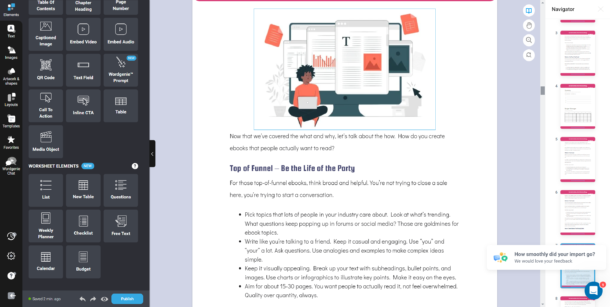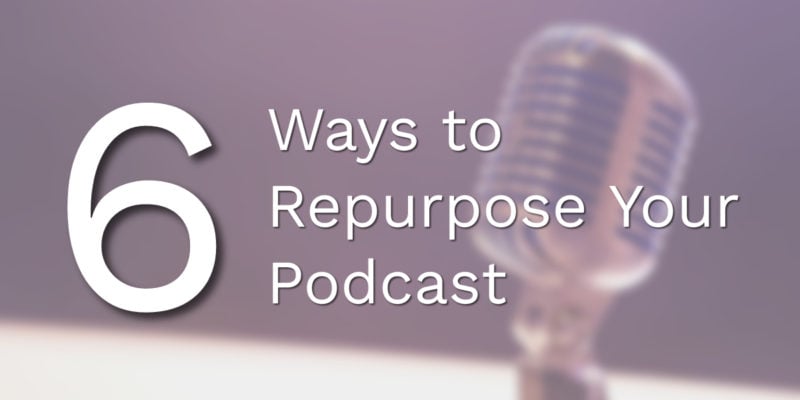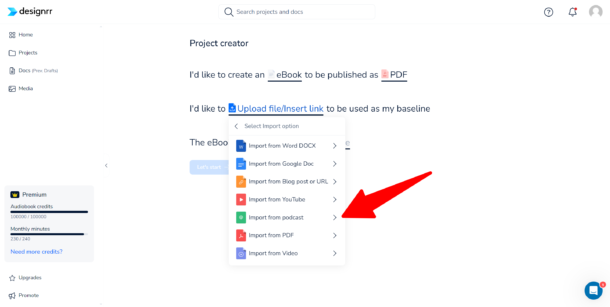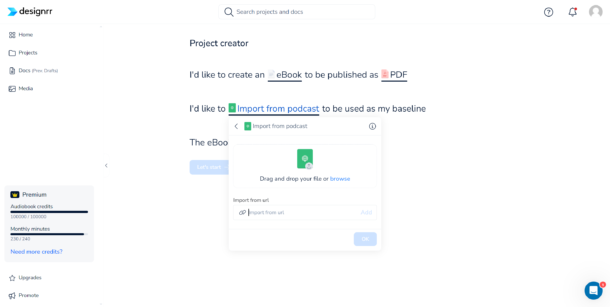You’ve created amazing podcast episodes, but are they reaching their full potential?
Repurposing your content expands your audience and squeezes more value from your hard work.
This guide will show you how to transform your audio content into various formats, attracting new listeners and keeping your current fans engaged.
Why Repurpose Your Podcast?
Repurposing isn’t just a trendy term – it’s a game-changer for your content strategy. Here’s what it can do for you:
- Attract readers and visual learners who might not listen to podcasts
- Boost your SEO, making your content more discoverable
- Extend the lifespan of your episodes
- Provide value to your audience in multiple ways
Let’s go through each effective ways to repurpose your podcast content and expand your reach.

1. Transform Episodes into Blog Posts
Turn your audio into written content that search engines love and readers devour. Follow these steps:
Use tools like Designrr or Descript to create a quick first draft.
Break the content into logical sections with clear headings. This makes it easier for readers to scan and digest the information.
Include research, examples, or insights that didn’t make it into the audio. This gives readers a reason to engage with your written content even if they’ve already listened to the episode.
Use relevant keywords naturally throughout the post. This helps people find your content when searching for topics related to your podcast.
Encourage readers to listen to the full episode. This can help convert readers into loyal podcast listeners.
Pro tip: Don’t just copy-paste your transcript. Create a well-structured article that stands on its own merit. Your goal is to provide value, not just regurgitate information.
2. Create Eye-Catching Visuals
Visual content grabs attention and conveys information quickly. Try these ideas:
Pull standout moments from your episodes and turn them into shareable graphics. These work great on social media and can pique interest in your full episodes.
If your podcast includes surprising statistics or facts, turn them into eye-catching visuals. People love sharing interesting data, especially when it’s presented in an appealing way.
Summarize complex topics from your episodes in a visual format. Infographics can break down complicated ideas into easily digestible chunks.
Create short, animated audio snippets with text overlay. These give social media users a taste of your content without requiring them to commit to a full episode.
Tools like Canva or Adobe Spark make it easy to create professional-looking visuals, even if you’re not a design expert. Experiment with different styles to see what resonates with your audience.
3. Create Video Content

Video opens up a world of new content possibilities.
Here’s how to get started:
Record your podcast sessions: If you’re not already doing this, start now. Video recordings give you a wealth of content to work with beyond just audio.
Edit highlight reels: Create short, engaging clips featuring the best moments from your episodes. These are perfect for sharing on social media or using as teasers for full episodes.
Create standalone videos: Expand on popular topics from your podcast in dedicated video segments. This allows you to dive deeper into subjects your audience is interested in.
Host live video Q&As: Address listener questions in real-time. This builds a stronger connection with your audience and can provide content for future episodes.
Don’t worry about having fancy equipment.
Even simple, talking-head style videos can provide value to your audience. The key is to start creating and refine your process over time.
4. Craft an Engaging Newsletter

Your email list is a direct line to your most dedicated fans. Make the most of it with these strategies:
- Recap recent episodes: Give subscribers a quick overview of what they might have missed. This reminds them to catch up on episodes they haven’t listened to yet.
- Offer exclusive content: Share behind-the-scenes tidbits or bonus material related to recent episodes. This gives subscribers a reason to open your emails and feel like insiders
- Tease upcoming content: Build excitement for future episodes or guests. This can help ensure your subscribers tune in as soon as new content drops.
- Encourage feedback: Use your newsletter to spark conversations and gather listener input. This can provide valuable insights for future content and make your audience feel heard.
Remember, your newsletter should provide value beyond what’s in the podcast itself. Give your subscribers content they can’t get anywhere else, making your emails must-reads.
5. Make the Most of Social Media Platforms

Each social media platform offers unique ways to share your podcast content. Here’s how to tailor your approach for each:
X
X or Twitter’s fast-paced nature works well for quick information and engaging discussions. Try these strategies:
- Create threads summarizing key episode points. Break down your main ideas into digestible tweets.
- Share short audio clips with captions. Give followers a sample of your podcast’s content.
- Post thought-provoking questions from your discussions to spark conversations.
- Use relevant hashtags to help more people find your content.
- Live-tweet interesting facts or quotes while recording your podcast.
- Run Twitter polls related to your podcast topics to boost engagement.
Instagram’s visual focus lets you get creative with your podcast promotion. Here’s how:
- Share quote graphics in your feed. Turn memorable lines from your episodes into visually appealing posts.
- Use Stories for behind-the-scenes peeks at your recording process. This helps listeners connect with you.
- Create longer videos diving deeper into episode topics.
- Use Instagram Reels to create short, engaging video content related to your podcast.
- Use Instagram’s carousel feature to share multiple images or infographics from a single episode.
- Host Instagram Lives to interact with your audience in real-time.
- Use relevant hashtags and location tags to help more people discover your content.
Facebook’s diverse features help build community around your podcast. Try these tactics:
- Host events for live recordings or Q&A sessions.
- Share longer video content, including full episode recordings if appropriate.
- Start community discussions around episode themes in a Facebook Group.
- Use Facebook Live to interact with your audience in real-time.
- Create and share event pages for upcoming episode releases or podcast-related events.
- Upload teasers or clips from your episodes using Facebook’s video feature.
LinkedIn’s professional audience appreciates in-depth, industry-specific content. Try these approaches:
- Write articles that expand on industry-specific subjects from your podcast.
- Post key insights as text updates to spark professional discussions.
- Upload short video clips for higher engagement.
- Share relevant infographics or data visualizations from your episodes.
- Use LinkedIn’s video feature to share teaser content or behind-the-scenes footage.
- Use LinkedIn’s publishing platform to share longer-form content from your podcast.
TikTok
TikTok’s short-form video format can help you reach younger audiences. Here’s how to adapt your podcast content:
- Create short, snappy video clips related to your content. Focus on delivering a single, impactful point.
- Use trending sounds or challenges to present your ideas in an entertaining way.
- Share quick tips or facts from your episodes.
- Join relevant hashtag challenges to increase visibility.
- Use TikTok’s duet feature to respond to other users’ content related to your podcast topics.
- Create behind-the-scenes content showing your podcast recording process.
- Try out TikTok’s various video effects to make your content more engaging and eye-catching.
Success on social media comes from consistency and engagement. Don’t just post your content and disappear. Interact with your followers, respond to comments, and join relevant conversations. This builds a community around your podcast and can lead to more loyal listeners and growth.
6. Launch an Online Course

Got educational content? Package it into a structured learning experience. Here’s how:
Choose a series of episodes that form a cohesive topic. This will be the foundation of your course.
Break down the content into modules and lessons that build on each other logically.
Develop worksheets, quizzes, or assignments that help students apply what they’ve learned.
Fill in any gaps or explain complex concepts in more detail. This adds value beyond what’s in your podcast episodes.
Set up your course on a platform like Teachable or Udemy. These make it easy to organize your content and manage students.
An online course not only serves your audience in a new way but can also open up a new revenue stream. It’s a win-win situation that allows you to monetize your expertise while providing in-depth value to your listeners.
7. Write an In-Depth Guide or Ebook

Some topics deserve more than just a podcast episode or blog post. A comprehensive guide or ebook can dive deep into a subject and provide lasting value to your audience.
Here’s how to create one:
Choose a broad subject: Pick a topic you’ve covered across multiple episodes. This ensures you have enough material to work with.
Outline the structure: Pull key points from relevant shows to create a roadmap for your writing.
Expand with fresh insights: Don’t just rehash what was in your podcast. Add new research, examples, and perspectives to give readers something fresh.
Include real-world examples: Use case studies to illustrate your points. This helps readers see how concepts apply in practical situations.
Add action steps: Give readers practical exercises or steps they can take to apply what they’ve learned.
Your guide can serve as a lead magnet to grow your email list, or you could sell your ebook as a product. Either way, it’s an excellent method to establish your authority on a topic and provide deep value to your audience.
Want to turn your podcast into an ebook? Try Designrr’s ebook creator.
Select what you want to create and the type of format. Upload your podcast URL and that’s it!
It will transcribe your audio into text using our audio/video transcription software.
Add photos, elements, ebook covers, CTA, and much more with our easy-to-use platform.

Check out Designrr’s special offer today!
8. Host Live Events or Webinars
Live events and webinars create real-time connections with your audience. Start by selecting a popular topic from your podcast that has sparked interest or questions. Prepare fresh content that goes beyond what you’ve covered in your episodes. This gives attendees a compelling reason to participate.
During the event, encourage active participation. Include Q&A sessions to address listener questions directly and foster engagement. Consider inviting past podcast guests for panel discussions, adding new perspectives to the conversation.
Don’t forget to record the event. This recording can be a goldmine for future content, such as highlight videos or blog posts. Live events not only build community among your listeners but also provide immediate feedback on your content. They deepen your connection with your audience and offer valuable insights for future episodes.
9. Develop a Mobile App
A mobile app can significantly enhance the listener experience for podcasts with a dedicated following. Focus on creating an intuitive interface that allows listeners to easily access and play episodes.
Consider these features:
- Easy playback: Make sure listeners can easily access and play episodes within the app.
- Show notes access: Provide quick access to any links or resources mentioned in your episodes.
- Exclusive content: Offer bonus material through the app to incentivize downloads and regular use.
- Push notifications: Alert listeners about new episodes without being intrusive.
- Interactive elements: Create quizzes or polls related to your content to boost engagement.
- Community features: Consider adding a forum where listeners can discuss episodes and connect with each other.
While developing an app requires more resources than other repurposing methods, it can significantly boost engagement and listener loyalty for the right podcast.
10. Create Physical Products

In our digital age, physical products offer a unique way to engage with your content. Consider compiling popular episodes into a book with fresh commentary. This gives listeners a new way to revisit your content and share it with others.
Design merchandise like t-shirts, mugs, or stickers featuring memorable quotes or inside jokes from your show. These items allow fans to show their support in tangible ways.
For a more interactive experience, develop a game based on your podcast theme. This could be anything from a simple trivia game to a more complex board game, depending on your content.
If your podcast focuses on personal development or productivity, create a planner or journal that incorporates ideas from your episodes. This gives your audience a practical tool to apply your content in their daily lives.
Physical products not only give your fans a way to engage with your content offline but can also provide an additional revenue stream to support your podcasting efforts.
Putting It All Together
These repurposing strategies offer numerous ways to expand your podcast’s reach and impact. Start with one or two methods that align with your strengths and audience preferences. As you get comfortable, gradually expand your efforts.
Key points to remember:
- Focus on quality over quantity. It’s better to execute a few strategies well than to spread yourself too thin.
- Maintain your brand voice across all content formats for consistency.
- Track the performance of your repurposed content and adjust your strategy based on what resonates with your audience.
- Experiment with new formats or platforms. You might discover unexpected wins.
- Always provide value. Each piece of repurposed content should offer something worthwhile to your audience.
Repurposing takes effort, but the payoff in increased reach, engagement, and impact makes it worthwhile. Start small, stay consistent, and watch your podcast’s influence grow beyond just audio.
Your podcast contains a wealth of valuable content. These repurposing strategies help you extract maximum value from each episode, serving your audience in multiple ways and establishing your authority in your niche. Now, it’s time to put these ideas into action and watch your podcast’s impact grow!


